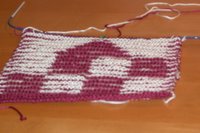 I have been playing around with shadow knitting to see how it works. I read about it in a book called Shadow Knitting by Vivian Hoxbro. Looking at the pictures in the book and reading through [several times] the first couple of chapters made me believe it was going to be a tough technique to learn. But in fact I found it quite intriguing and quite simple to do.
I have been playing around with shadow knitting to see how it works. I read about it in a book called Shadow Knitting by Vivian Hoxbro. Looking at the pictures in the book and reading through [several times] the first couple of chapters made me believe it was going to be a tough technique to learn. But in fact I found it quite intriguing and quite simple to do.Shadow weave is formed by using two colors of yarn, one light and one dark. You only knit one color at a time. Every row on the right side is knit. Every row on the wrong side is an alternating knit section and purl section [or visa versa] to acheive the shadow effect.
I decided to start with the pattern in the first project - the potholder - simple stripes. Once I got four or five rows down I was bored...switched the stripes to make a checkerboard pattern and finished it off with a triangle. The best part was a table she created to more easily follow the patterns. I just couldn't figure out the table until I actually started knitting. Then it was obvious. I had tried to do something similar to this a month ago - trying to get a triangle of garter stitch to rise out of some knit stitch. It was really tough to display on a piece of paper.

 In shadow knitting, by creating ridges & valleys of garter and stockinette stitch with two colors of yarn, a shadow is created which adds to the visual interest of the piece. It essentially adds another color without adding a new yarn. If you look from some directions- you really can't see the design but when looking at it from others the design pops out.
In shadow knitting, by creating ridges & valleys of garter and stockinette stitch with two colors of yarn, a shadow is created which adds to the visual interest of the piece. It essentially adds another color without adding a new yarn. If you look from some directions- you really can't see the design but when looking at it from others the design pops out.Obviously high value-low value selections of colors will make the patterns pop the most. The various clothes and things portrayed in the book use mostly black as one color and a variety of others for the second yarn. I can imagine how one could get some beautiful effects by moving down the value spectrum. Deb Menz' book Color Works would offer some good value choices to achieve specific effects. I like this technique and will try making a scarf with it. I have some lovely silk yarns that I might try. I bought one skein of every color so I could combine various colors in this technique with potentially some lovely results. Something to add to the to-do list.
 For my weaving friends...doesn't this seem a bit like shadow weaving? I was never hot on that weaving technique since the warping complexity never seemed to be worth the effort relative to the finished product. Here's a picture of some samples from a shadow weave workshop I took several years ago at an ASCH conference in Riverside. Looks pretty similar...
For my weaving friends...doesn't this seem a bit like shadow weaving? I was never hot on that weaving technique since the warping complexity never seemed to be worth the effort relative to the finished product. Here's a picture of some samples from a shadow weave workshop I took several years ago at an ASCH conference in Riverside. Looks pretty similar...Interesting that whenever I am asked to make a high-low value color selection I always select maroon never black as the high value color.
No comments:
Post a Comment